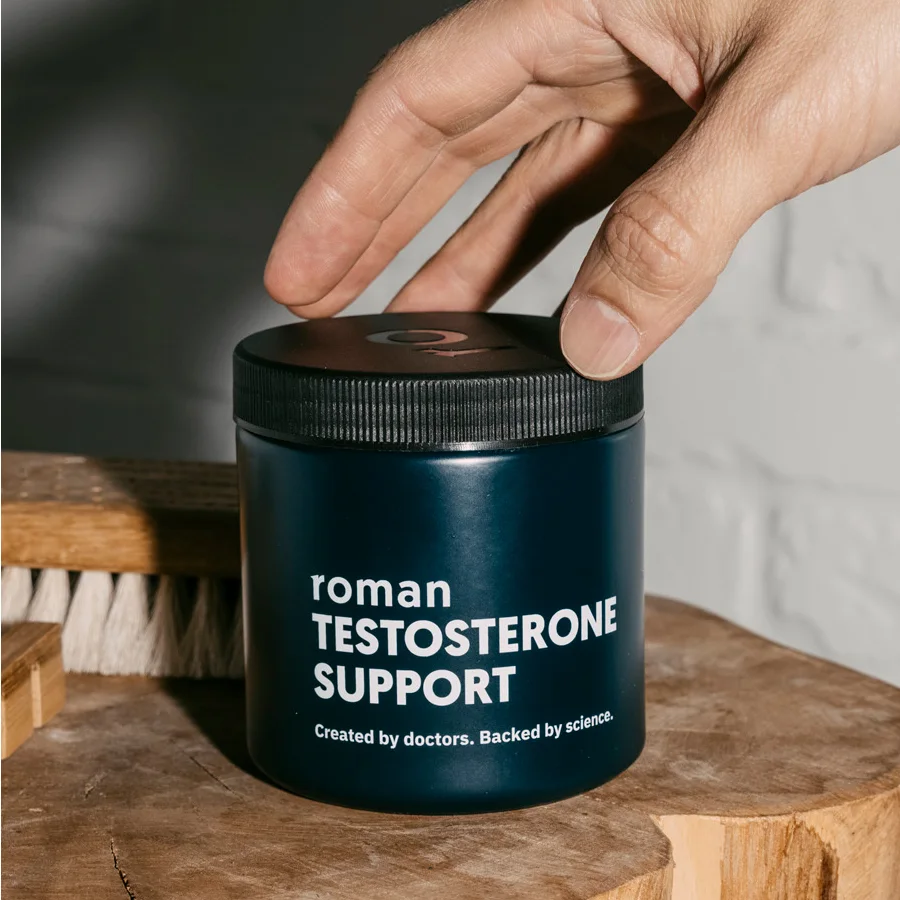Here's what we'll cover
Here's what we'll cover
Testosterone is a hormone present in both men and women, but it’s considered a “male sex hormone” since it plays a more significant role in many bodily processes in biological males. Testosterone is involved in sperm production, sex drive, and building muscle mass, among other essential functions. When someone has low testosterone levels (aka “low T”), it can lead to symptoms like decreased sexual function, loss of muscle mass, increased fat stores, and fatigue (Sizar, 2022).
If you’ve been diagnosed with low T or suspect that you may have it, continue reading to find out more about how to increase testosterone.
How do you know if you have low T?
Low T is a common diagnosis in men, as natural testosterone levels begin decreasing in a person’s mid-30s. According to some studies, testosterone levels decline about 1–2% a year, starting around age 30–40. An estimated 39% of men 45 or older have low testosterone (Miah, 2019; Mulligan, 2006).
The normal levels of testosterone in the blood are typically considered 300 ng/dL to 1000 ng/dL (Qaseem, 2020). According to the American Urological Association (AUA), having a value below 300 ng/dL is a “reasonable cut-off” to be diagnosed with low testosterone, which can trigger treatment (Mulhall, 2018).
Though we have a pretty clear range for normal testosterone levels, two people can have very different symptoms at different levels. That’s also why healthcare providers might still treat someone with slightly higher T levels, above the 300 ng/dL “cut-off,” if they have typical low T symptoms.
The symptoms of low testosterone can include (Qaseem, 2020):
Fatigue and decreased energy
Loss of muscle mass or difficulty gaining muscle
Increased fat in the body
Moodiness
Loss of facial or body hair
Osteoporosis
The above symptoms could be caused by low T as well as other medical conditions. If you experience any of these symptoms and suspect that you may have decreased testosterone, bring it up with your healthcare provider. There are tests that can be done to help determine if low T or something else might be causing your symptoms.
Typically, your provider will require two early morning tests on separate days before diagnosing you with low T since levels can fluctuate (Sizar, 2022).
Increasing testosterone with medications
If you’re diagnosed with low T, the most common approach is using medications under the guidance of your healthcare professional. There are multiple options:
Testosterone replacement therapy
Testosterone replacement therapy (TRT) can be given in multiple ways: through the skin in either gel or patch form, or as an intramuscular injection. Gel products are applied to the arm, shoulder, or abdomen, then absorbed into the skin. Injections are usually given in the muscle and can be administered in a healthcare office or self-administered at home. The dose and frequency of TRT is different for each individual (Sizar, 2022).
Side effects that can occur with TRT include (MedLine Plus, 2019):
Skin irritation where gel or patch was used
Breast enlargement (gynecomastia)
Decrease in sperm count
Smaller testicle size
Mood swings
Increased red blood cell counts
Difficulty sleeping
Headaches
Increased risk of blood clots
With regular use of TRT, the body can stop producing testosterone naturally. This could be a problem when stopping TRT, as it can take some time for the body to start making testosterone again. For most men, once they start TRT, they’ll be on it long-term.
Clomid
Another medication that raises testosterone levels is Clomid, so it’s often prescribed off-label to help increase testosterone in men. Usually taken once a day or every other day, studies have shown that taking Clomid can increase testosterone through a unique mechanism of action. It tricks your body into thinking that your sex hormone levels are lower than they are, leading it to increase testosterone levels. In men, clomiphene helps to increase the natural production of testosterone and sperm in the testes (Mbi Feh, 2022).
Unlike testosterone replacement therapy (TRT), one of the main benefits of Clomid for low T is that clomiphene does not interfere with sperm production—which is critical for men who want to preserve their fertility (Wheeler, 2019). Clomid may not be the fix for every man trying to raise his testosterone levels, and because it’s used off-label, it may not be covered by insurance. However, it is usually well tolerated and doesn’t have the same side effects as TRT.
How to naturally increase testosterone: 4 strategies
There’s only so much you can do to fight aging, including the natural decline in testosterone as you get older. Still, some strategies can help you optimize your testosterone levels. However, if you have clinically diagnosed low testosterone or a medical condition that causes low T, these strategies can’t replace, but rather support, treatment of that condition
1. Maintain a healthy body weight
One of the most important strategies is maintaining a healthy body weight. Extra body fat can contribute to decreased testosterone levels (Lo, 2018).
If you have excess weight or obesity, weight loss through aerobic exercise (cardio) and resistance training (weight lifting) can decrease fat stores and help you build muscle. These have both been associated with maintaining higher levels of testosterone in the body. One small study showed that combining intensity and resistance training led to an increase in testosterone levels that lasted up to 48 hours after the workout (Lo, 2018; Riachy, 2020).
2. Eat a nutritious diet
Studies suggest that adopting healthy eating patterns may promote T production.
Dietary considerations include decreasing the amount of sugar, dairy products, and red meats you eat, as these are linked to low testosterone levels. Be sure to eat healthy fats (like nuts or fish), and increase dietary fiber (through whole grains, fruits, and vegetables) to help keep you full and prevent weight gain from unhealthy fats and carbohydrates. Within reason, it’s a good idea to limit simple carbs and overly processed foods (Skoracka, 2020; Lo, 2018).
3. Get enough sleep
Sleep is an important factor in testosterone production. The body makes most of its testosterone during sleep, so if you’re not getting enough sleep or your sleep is low quality (e.g., you have trouble falling or staying asleep or have sleep apnea), you might see your testosterone levels decline (Liu, 2019).
4. Avoid unhealthy substances
Other ways to naturally support testosterone include avoiding tobacco products, limiting alcohol, and managing stress (easier said than done, right?) (Lo, 218).
Most men will experience some level of testosterone decline as they age. If the loss of testosterone is significant and causes symptoms, it is definitely something to discuss with your healthcare provider. They can complete a workup to see if you require any prescription treatments or may be able to increase your testosterone levels naturally. Having low T can affect not only your sexual health but your overall health as well.
DISCLAIMER
If you have any medical questions or concerns, please talk to your healthcare provider. The articles on Health Guide are underpinned by peer-reviewed research and information drawn from medical societies and governmental agencies. However, they are not a substitute for professional medical advice, diagnosis, or treatment.
Da Ros, C. T. & Averbeck, M. A. (2012). Twenty-five milligrams of clomiphene citrate presents positive effect on treatment of male testosterone deficiency-a prospective study. International Brazilian Journal of Urology , 38 , 512-518. doi:10.1590. Retrieved from https://www.scielo.br/j/ibju/a/gVjRJ6FvJ33NLPkVsCXXj4L/
Lerchbaum, E., Pilz, S., Trummer, C., et al. (2017). Vitamin D and testosterone in healthy men: a randomized controlled trial. The Journal of Clinical Endocrinology & Metabolism , 102 (11), 4292-4302. doi:10.1210/jc.2017-01428. Retrieved from https://academic.oup.com/jcem/article/102/11/4292/4096785
Lo, E. M., Rodriguez, K. M., Pastuszak, A. W., & Khera, M. (2018). Alternatives to testosterone therapy: a review. Sexual Medicine Reviews , 6 (1), 106-113. doi:10.1016/j.sxmr.2017.09.004. Retrieved from https://www.sciencedirect.com/science/article/pii/S2050052117301221
Liu, P. Y. (2019). A clinical perspective of sleep and andrological health: assessment, treatment considerations, and future research. The Journal of Clinical Endocrinology and Metabolism , 104 (10), 4398–4417. doi:10.1210/jc.2019-00683. Retrieved from https://www.ncbi.nlm.nih.gov/pubmed/3104227
Mbi Feh, M. K. & Wadhwa, R. (2022). Clomiphene. StatPearls . Retrieved on Sept. 22, 2022 from https://www.ncbi.nlm.nih.gov/books/NBK559292/
MedlinePlus. (2019). Testosterone injection . Retrieved from https://medlineplus.gov/druginfo/meds/a614041.html
Miah, S., Tharakan, T., Gallagher, K. A., et al. (2019). The effects of testosterone replacement therapy on the prostate: a clinical perspective. F1000Research, 8 , F1000 Faculty Rev-217. doi:10.12688/f1000research.16497.1. Retrieved from https://www.ncbi.nlm.nih.gov/pmc/articles/PMC6392157/
Mulligan, T., Frick, M. F., Zuraw, Q. C., et al. (2006). Prevalence of hypogonadism in males aged at least 45 years: the HIM study. International Journal of Clinical Practice, 60 (7), 762–769. doi:10.1111/j.1742-1241.2006.00992. Retrieved from https://pubmed.ncbi.nlm.nih.gov/16846397/
Mulhall, J. P., Trost, L. W., & Brannigan, R. E., et al. (2018). Evaluation and management of testosterone deficiency: AUA Guideline. Journal of Urology, 200 , 423. doi:10.1016/j.juro.2018.03.115. Retrieved from https://pubmed.ncbi.nlm.nih.gov/29601923/
Qaseem, A., Horwitch, C. A., Vijan, S., et al. (2020). Testosterone treatment in adult men with age-related low testosterone: a clinical guideline from the American College of Physicians. Annals of Internal Medicine , 172 (2), 126-133. doi:10.7326/M19-0882. Retrieved from https://pubmed.ncbi.nlm.nih.gov/31905405/
Riachy, R., McKinney, K., & Tuvdendorj, D. R. (2020). Various factors may modulate the effect of exercise on testosterone levels in men. Journal of Functional Morphology and Kinesiology , 5 (4), 81. doi:10.3390/jfmk5040081. Retrived from https://www.ncbi.nlm.nih.gov/pmc/articles/PMC7739287/
Sizar, O. & Schwartz, J. (2022). Hypogonadism. StatPearls. Retrieved on Sept. 20, 2022 from https://www.ncbi.nlm.nih.gov/books/NBK532933/
Skoracka, K., Eder, P., Łykowska-Szuber, L., et al. (2020). Diet and nutritional factors in male (in)fertility-underestimated factors. Journal of Clinical Medicine , 9 (5), 1400. doi:10.3390/jcm9051400. Retrieved from https://www.ncbi.nlm.nih.gov/pmc/articles/PMC7291266/
Wheeler, K. M., Sharma, D., Kavoussi, P. K., et al. (2019). Clomiphene citrate for the treatment of hypogonadism. Sexual Medicine Review, 7 (2), 272-276. doi: 10.1016/j.sxmr.2018.10.001. Retrieved from https://pubmed.ncbi.nlm.nih.gov/30522888/










